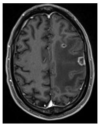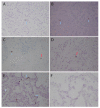Detection of SARS-CoV-2 RNA by In Situ Hybridization in Lung-Cancer Cells Metastatic to Brain and in Adjacent Brain Parenchyma
- PMID: 37375462
- PMCID: PMC10302960
- DOI: 10.3390/pathogens12060772
Detection of SARS-CoV-2 RNA by In Situ Hybridization in Lung-Cancer Cells Metastatic to Brain and in Adjacent Brain Parenchyma
Abstract
The mechanisms by which severe acute respiratory syndrome coronavirus 2 (SARS-CoV-2) may spread to the human brain are poorly understood, and the infection of cancer cells in the brain by SARS-CoV-2 in Coronavirus disease 2019 (COVID-19) patients has been the subject of only one previous case report. Here, we report the detection of SARS-CoV-2 RNA by in situ hybridization in lung-cancer cells metastatic to the brain and adjacent brain parenchyma in a 63-year-old male patient with COVID-19. These findings suggest that metastatic tumors may transport the virus from other parts of the body to the brain or may break down the blood-brain barrier to allow for the virus to spread to the brain. These findings confirm and extend previous observations that cancer cells in the brain can become infected by SARS-CoV-2 in patients with COVID-19 and raise the possibility that SARS-CoV-2 can have a direct effect on cancer growth and outcome.
Keywords: SARS-CoV-2; brain; cancer; clinical case/report; in situ hybridization; metastatic carcinoma.
Conflict of interest statement
The authors declare no conflict of interest.
Figures



Similar articles
-
Ocular Pathology and Occasionally Detectable Intraocular Severe Acute Respiratory Syndrome Coronavirus-2 RNA in Five Fatal Coronavirus Disease-19 Cases.Ophthalmic Res. 2021;64(5):785-792. doi: 10.1159/000514573. Epub 2021 Jan 20. Ophthalmic Res. 2021. PMID: 33472206
-
Evidence of Severe Acute Respiratory Syndrome Coronavirus 2 Replication and Tropism in the Lungs, Airways, and Vascular Endothelium of Patients With Fatal Coronavirus Disease 2019: An Autopsy Case Series.J Infect Dis. 2021 Mar 3;223(5):752-764. doi: 10.1093/infdis/jiab039. J Infect Dis. 2021. PMID: 33502471 Free PMC article.
-
Comparison of In Situ Hybridization, Immunohistochemistry, and Reverse Transcription-Droplet Digital Polymerase Chain Reaction for Severe Acute Respiratory Syndrome Coronavirus 2 (SARS-CoV-2) Testing in Tissue.Arch Pathol Lab Med. 2021 Jul 1;145(7):785-796. doi: 10.5858/arpa.2021-0008-SA. Arch Pathol Lab Med. 2021. PMID: 33720333
-
COVID-19 and cognitive impairment: neuroinvasive and blood‒brain barrier dysfunction.J Neuroinflammation. 2022 Sep 7;19(1):222. doi: 10.1186/s12974-022-02579-8. J Neuroinflammation. 2022. PMID: 36071466 Free PMC article. Review.
-
Pathological diagnosis of Coronavirus-related nephropathy: insight from postmortem studies.Crit Rev Clin Lab Sci. 2021 Dec;58(8):563-575. doi: 10.1080/10408363.2021.1944047. Epub 2021 Jul 8. Crit Rev Clin Lab Sci. 2021. PMID: 34236278 Review.
Cited by
-
Equivocating and Deliberating on the Probability of COVID-19 Infection Serving as a Risk Factor for Lung Cancer and Common Molecular Pathways Serving as a Link.Pathogens. 2024 Dec 6;13(12):1070. doi: 10.3390/pathogens13121070. Pathogens. 2024. PMID: 39770330 Free PMC article. Review.
References
-
- Chan J.F., Yuan S., Kok K.H., To K.K., Chu H., Yang J., Xing F., Liu J., Yip C.C., Poon R.W., et al. A familial cluster of pneumonia associated with the 2019 novel coronavirus indicating person-to-person transmission: A study of a family cluster. Lancet. 2020;395:514–523. doi: 10.1016/S0140-6736(20)30154-9. - DOI - PMC - PubMed
Publication types
LinkOut - more resources
Full Text Sources
Miscellaneous

